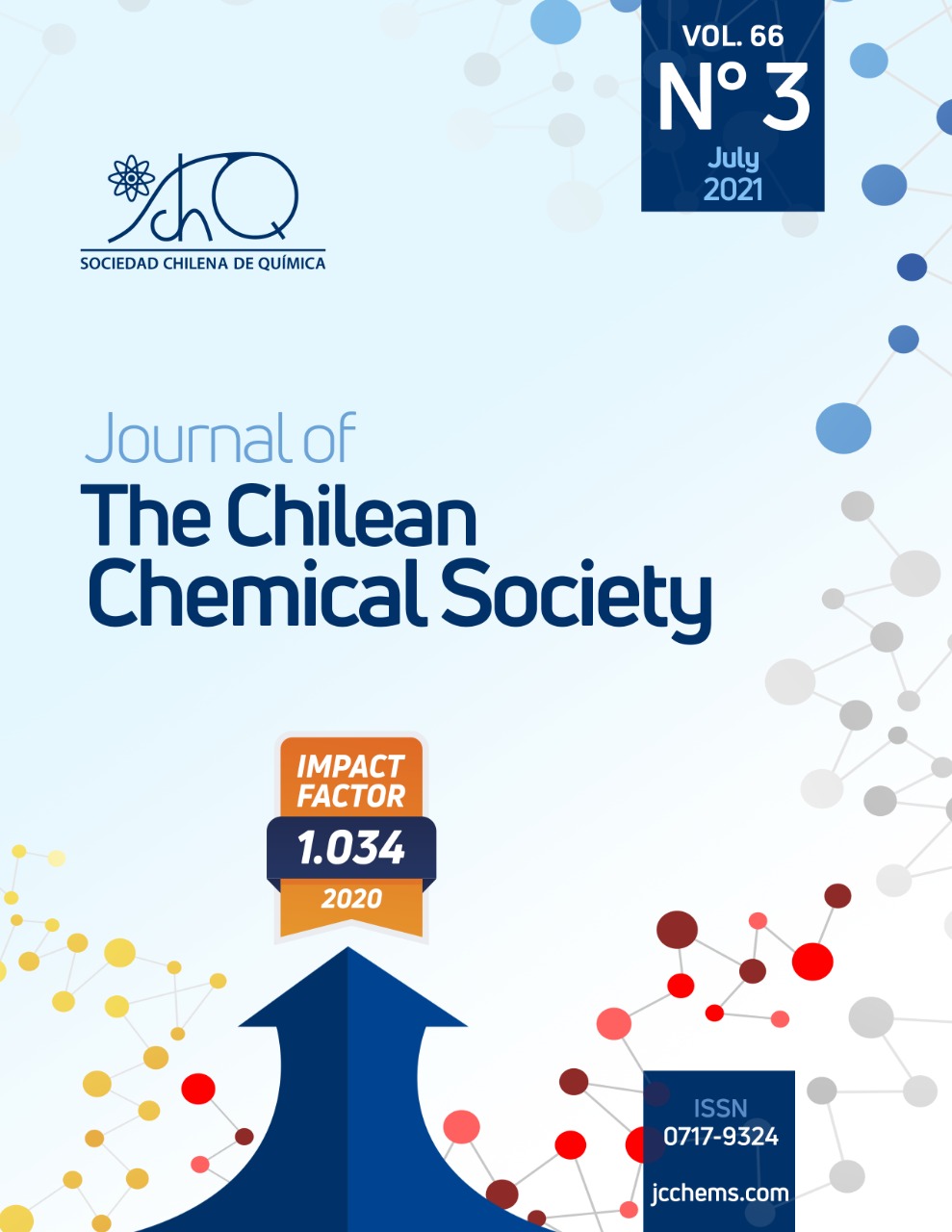VOLATILE PROFILE AND CONSUMER ACCEPTABILITY OF NATURAL YOGHURTS ELABORATED WITH CHILEAN NATIVE CULTURES OF Enterococcus sp. STRAIN BB3 AND Lactobacillus sp. STRAIN BB6

- Functional Probiotic Yoghurt,
- Autochthonous Starter cultures,
- Lactic Acid Bacteria,
- Volatile Compounds,
- CG-MS
Copyright (c) 2021 SChQ

This work is licensed under a Creative Commons Attribution-NonCommercial-ShareAlike 4.0 International License.
Abstract
According to WHO, in 2016 around 13% of the world's adult population (11% of men and 15% of women) were obese. The global prevalence of obesity almost tripled between 1975 and 2016. In this context, it is important to note that the continuous increase in life expectancy, the desire for a better quality of life, and the high cost of medical care have led to a growing demand for functional foods in the market. People have started to realize that their food choices and their unhealthy lifestyles have consequences for their health. An important role in this scenario is associated with functional foods containing probiotic strains, reported to be beneficial for human health. Here we report the development of natural yoghurts based on native probiotic starter cultures of Enterococcus sp. strain BB3 (MK681869) and Lactobacillus sp. strain BB6 (MK681868), isolated from raw cow milk of La Araucanía region of Chile. The odour and taste were the main parameter criticized by the consumer, the analysis of CG-MS elucidated that the yoghurt produced by the strain Enterococcus sp. strain BB3 (MK681869) produced a higher amount of heptan-2-one, associated with a cheesy type odour, with less acceptance by the consumers. The acceptability of 6 types of yoghurt was evaluated with a randomized analysis of 60 participants. The development of a functional dairy product based on probiotics is of interest because of its relation with positive changes in gut microbiota, and at the same time with a possible decrease in body weight.

References
- I. Jankovic, W. Sybesma, P. Phothirath, E. Ananta, A. Mercenier, Curr. Opin. Biotechnol. 21, 175, (2010).
- M.F. Chen, Appetite. 57, 253, (2011).
- M. H. Floch, Gastroenterol. Clin. North Am. 47, 179, (2018).
- M. L. Battson, D. M. Lee, T. L. Weir, C. L. Gentile, J. Nutr. Biochem. 56, 1, (2018).
- F. Tsai, W. J. Coyle, Curr. Gastroenterol. Rep. 11, 307, (2009).
- W. M. de Vos, E. A. de Vos, Nutr. Rev. 70, S45, (2012).
- P. J. Turnbaugh, F. Bäckhed, L. Fulton, J. I. Gordon, Cell Host Microbe. 3, 213, (2008).
- E. D. Sonnenburg, H. Zheng, P. Joglekar, S. K. Higginbottom, S. J. Firbank, D. N. Bolam, J. L. Sonnenburg, Cell. 141, 1241, (2010).
- B. Goetzke, S. Nitzko, A. Spiller, Appetite. 77, 96, (2014).
- F. Melini, V. Melini, F. Luziatelli, A. G. Ficca, M. Ruzzi, Nutrients. 11, 1189, (2019).
- J. Burgain, C. Gaiani, M. Linder, J. Scher, J. Food Eng. 104, 467, (2011).
- A. Astrup, Am. J. Clin. Nutr. 99, 1235S, (2014).
- E. W. Ng, M. Yeung, P. S. Tong, Int. J. Food Microbiol. 145, 169, (2011).
- D. Wang, W. Liu, Y. Ren, L. De, D. Zhang, Y. Yang, Q. Bao, H. Zhang, B. Menghe, Korean J. Food Sci. Anim. Resour. 36, 499, (2016).
- A. J. Rondón, L. M. Samaniego, R. Bocourt, S. Rodríguez, G. Milián, M. J. Ranilla, M. Laurencio, M. Pérez, Cienc. y Tecnol. Aliment. 6, 56, (2008).
- T. A. Peace, K. V. Brock, H. F. Stills, Int. J. Syst. Bacteriol. 44, 832, (1994).
- B. Nielsen, G. C. Gürakan, G. Ünlü, Probiotics Antimicrob. Proteins. 6, 123, (2014).
- A. Machado, D. O. Leite, M. Antonio, L. Miguel, R. S. Peixoto, A. S. Rosado, J. T. Silva, V. Margaret, F. Paschoalin, Brazilian J. Microbiol. 349, 341, (2013).
- I. Acevedo Pons, O. García, J. Contreras, I. Acevedo, Rev. Cient. UDO Agric. 9, 442, (2009).
- C. Catania, S. Avagnina, Curso Super. degustación vinos, 26, (2007).
- H. Cheng, Crit. Rev. Food Sci. Nutr. 50, 938, (2010).
- A. Ott, L. B. Fay, A. Chaintreau, J. Agric. Food Chem. 45, 850, (1997).
- S. M. O’Mahony, G. Clarke, Y. E. Borre, T. G. Dinan, J. F. Cryan, Behav. Brain Res. 277, 32, (2015).
- N. C. de Clercq, A. K. Groen, J. A. Romijn, M. Nieuwdorp, Adv. Nutr. An Int. Rev. J. 7, 1080, (2016).
- D.-H. Kim, D. Jeong, I.-B. Kang, H. Kim, K.-Y. Song, K.-H. Seo, Mol. Nutr. Food Res. 61, 1700252, (2017).
- A. K. Mishra, A. R. Ghosh, Probiotics Antimicrob. Proteins. 10, 435, (2018).
- M. Kondoh, T. Shimada, K. Fukada, M. Morita, K. Katada, Y. Higashimura, K. Mizushima, M. Okamori, Y. Naito, T. Yoshikawa, Br. J. Nutr. 112, 868, (2014).
- A. Saint-Eve, H. Leclercq, S. Berthelo, B. Saulnier, W. Oettgen, J. Delarue, Appetite. 99, 277, (2016).
- M. L. Marco, D. Heeney, S. Binda, C. J. Cifelli, P. D. Cotter, B. Foligné, M. Gänzle, R. Kort, G. Pasin, A. Pihlanto, E. J. Smid, R. Hutkins, Curr. Opin. Biotechnol. 44, 94, (2017).
- J. L. Revuelta, C. Serrano-Amatriain, R. Ledesma-Amaro, A. Jiménez, Appl. Microbiol. Biotechnol. 102, 8613, (2018).
- S. Viscardi, L. Marileo, P. J. Barra, P. Durán, C. Inostroza-Blancheteau, Curr. Opin. Food Sci. 34, 1, (2020).
- C. H. Edwards, M. Rossi, C. P. Corpe, P. J. Butterworth, P. R. Ellis, Trends Food Sci. Technol. 56, 158, (2016).
- A. D. Mooradian, M. Smith, M. Tokuda, Clin. Nutr. ESPEN. 18, 1, (2017).
- D. D. Pan, Z. Wu, T. Peng, X. Q. Zeng, H. Li, J. Dairy Sci. 97, 624, (2014).
- B. Schnettler, C. Shene, M. Rubilar, H. Miranda, J. Sepúlveda, M. Denegri, G. Lobos, Arch. Latinoam. Nutr. 60, 380, (2010).

